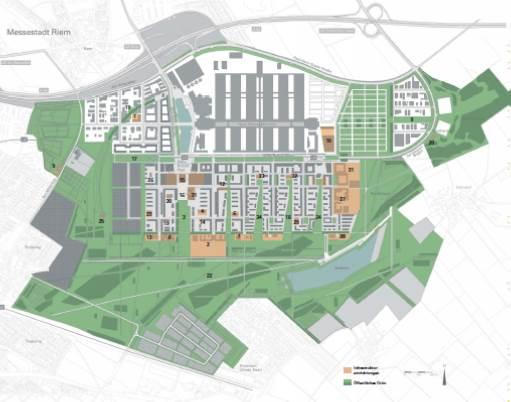International Practice in Site Master Planning

Messestadt Riem
Industrial Parks are often not well planned and have a limited number of common services. Providing such services can become very expensive at later stages as companies are not allocated or grouped well. Integrating sustainable industrial development models from the beginning could lead to win-win situations for the developer, the companies/investors, the environment and the surrounding communities.
Main features and components
Site Master Planning includes site suitability assessment, zoning/plotting of the site based on the pollution potential of industries, restrictions on certain types of polluting industries, planning of common environmental infrastructure and utilities for recycling/reuse of waste water, solar energy usage, plantation/green buffers etc.
Some of the key elements of the Site Master Plan are:
- Zoning of industries and definition of block sizes and width of infrastructure corridors as per industrial development requirements
- Electricity distribution concept, substations, co-generation plant
- Steam, compressed air network
- Potable, industrial and firefighting water
- Logistics concept
- Access to air, road, rail and sea
- Location of logistic hub, warehouses
- Drainage concept including rain water harvesting, recycle/reuse
- Definition of utility and wastewater networks, treatment plants and their appropriate location
- Green belts, buffer zones
- Resource conservation at the site – protection of ground water recharge zones, plantation areas, natural water bodies, avoid salt water intrusion
- Industrial and hazardous waste – collection, storage, transport, treatment and disposal & recycling (landfill, incineration...)
- Centre for Safety, Security and Environment – serves as emergency response centre (fire, chemical hazard, incidents), monitors eco-relevant data
- Energy conservation measures including use of renewable energy sources
- Disaster management
- Management and service concept for operation of Industrial Park (park management, management of services/utilities/ facilities etc.) upon its commencement
Implementation and work steps
- Assessment of types of industries/investments
- Assessment of demands/potentials/resources/risks
- Formulation of a vision and strategy
- Assessment of environmental infrastructure requirements viz. CETP, waste landfill/incinerator, cogeneration, green belts/buffer zones, water harvesting, environment laboratory, testing etc.
- Environmental impact assessment
- Site master planning
- Development of a code for block development
- Development of plot allotment guidelines
- Development of a management and service concept
Lessons learnt
The Bayer Chemical Park at Leverkusen in Germany was established in 1891. The industrial plants changed but the park exists successful because of proper planning.
Requirements
Information about the industries and possible investments attracted to the park should be available
Output
The detailed site master plan comes with plot allotment guidelines, a park management concept and a concept for services in the park.
Advantages of a Well Planned Industrial Park
- Proper zoning of industries, optimised synergies and shared services leading to increased efficiency by individual industries
- Optimal utilisation of land with high density of production units
- Attractiveness for high investments
- Economy of scale for services with many common service
- Investors are able to concentrate on the core business, while the services/synergies/ management is organised by the Industrial Park Management
- Has marketing advantage for foreign investors
- Environmental friendly park
- A high level of acceptance of the site in the surroundings
- Well planned park management
Environmental Benefits
- Reduction of greenhouse gases
- Segregation of growth and energy and resource consumption in industrial parks
- Reduction of negative environmental impacts (land contamination, emissions, waste, wastewater, damage to biological diversity etc.) in selected industrial establishments
- Reduction of specific usage of natural resources (energy, raw materials, water) in production processes of selected industrial sectors
- Adapting to changing climatic conditions: above all excessive rain, water shortage and temperature increase
- Decrease in emissions, wastewater and waste, which are adverse to good health for the surrounding population
Downloads
Characteristics
Phase of intervention
Designing SIA, Master planning
Level of intervention
Planning level
Regions
Asia, Europe
Countries
Germany, India
Target groups
Industrial area management and operator, Local and international consultant and advisor, Municipality, Policy makers, Private investors